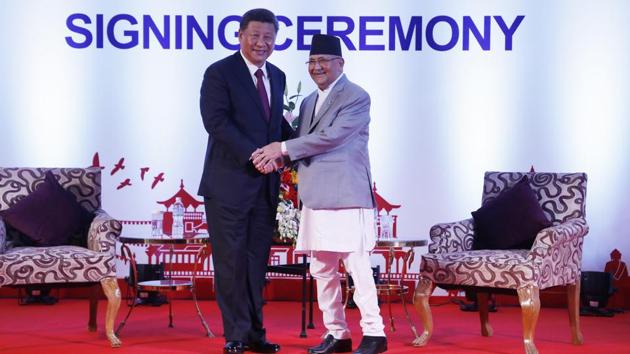When China and Nepal became ‘strategic partners’ | Analysis
How ties evolve now will depend on Kathmandu’s ability to manage geopolitics and project implementation
The visit may have been short, but it was heavy on optics and impact. With Chinese President Xi Jinping’s Kathmandu visit now concluded, there is a newfound confidence in the Nepali establishment that much-vaunted infrastructure projects, not least the Kerung-Kathmandu railway plan, will get the momentum they were in dire need of. “The bilateral relationship between Nepal and China has entered a new phase,” reads the joint communiqué, elevating ties to one of “strategic partnership” for the first time. How that strategic partnership will come to be defined remains to be seen, but within the statement are a few markers that suggest the way forward for Nepal-China ties.

First, both countries have agreed to intensify the implementation of projects under the Belt and Road Initiative, now to be developed under the Trans-Himalayan Multidimensional Connectivity Network umbrella first announced in 2018. Although the funding modality of the Detailed Project Report for the railway is yet to be decided, China has agreed to start work. More importantly, the rail network will extend to Pokhara and Lumbini.
But the railway is just one part of the bonanza, and dependent on the Tibet rail network first reaching Kerung itself. With much of the focus remaining on connectivity, China will first build a critical road stretch between Kathmandu and Rasuwagadhi that will reduce the distance to the northern border significantly. The Rasuwagadhi border has emerged as a key alternative to the Tatopani border, which recently opened after the 2015 earthquake damaged it. Nepal’s foreign minister, Pradeep Gyawali, said the railway project is complicated, and expects the tunnel project to be completed before the former.
Nepal’s quest for connectivity received a further boost with China agreeing on principle to develop the key border points of Mustang, north of Pokhara, and Kimathanka in the east. Along with Hilsa in the west, these border crossings will be the roadheads for the three north-south road corridors China has also agreed to develop. Xi also announced Nepalese rupee (NRs) 56 billion in assistance over the next two years, before saying China would assist Nepal in becoming a “land-linked” country from a “land-locked” one.
More than two dozen agreements were signed, but the substance of Xi’s visit was clear. China prioritises Nepal, as a Kantipur editorial said, and offered to closely partner with Nepal for connectivity. If the projects and agreements move forward as expected, the editorial said, it will free Nepal from its dependence on India for imports.
Although Nepal’s current tilt to the north began after the 2015 blockade, Xi’s visit marks a new landmark in bilateral relations. Beyond the optics of a sitting Chinese president visiting the country in 23 years, the declaration of a strategic partnership will be of particular interest in the days to come. Local analysts have interpreted this as the importance of Nepal in China’s worldview.
There had been talk of an extradition treaty being signed before Xi’s visit, a development that was quashed by the government. But discussions have been ongoing, and the statement has called for “an early conclusion” on the treaty. Whether the delay has been because of Nepal’s international refugee commitments, or the fact that it hasn’t updated the old 1953 agreement with India despite the latter’s insistence, isn’t clear.
However, let that not deter attention from the agreement to “strengthen cooperation between the law enforcement agencies on information exchanges, capacity building and training”, with 100 Nepali security personnel travelling to China every year till 2022. This ties in with recent Chinese assistance in security infrastructure development and greater aid to districts bordering Tibet. Beijing’s largesse also indicates its satisfaction with Kathmandu’s cooperation in all matters Tibetan.
But the road ahead isn’t as smooth as it seems. The US is keen Kathmandu make its position clear on the Indo-Pacific strategy, while China itself may have issues with Nepal’s lack of movement on prior commitments. Xi’s statement at the welcome dinner saying “We’ve completed projects we’ve built and initiated. We’ve done the same in China (translation mine)” has been alluded as him advising Nepal to do the same.Further, despite increasing rapprochement between Delhi and Beijing, a new paradigm hasn’t appeared in Nepal-India relations post 2015.
However, the mood in Kathmandu is upbeat. Xi’s visit paid attention to the cultural and people-to-people links between the two countries, and it is likely that Chinese tourists will once again top the number of visitors to Nepal next year even as more exchanges will take place. “The flame runs high when everyone adds wood to the fire,” Xi quoted a Chinese proverb in an op-ed published across major newspapers before his visit. The fire has been lit. Now it is Nepal’s turn to put in the wood.






